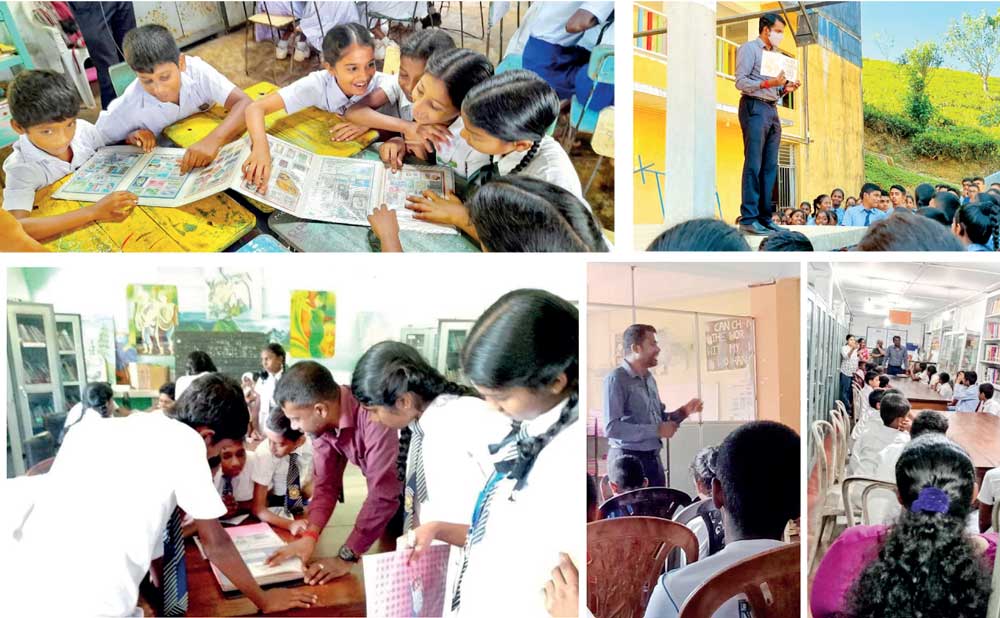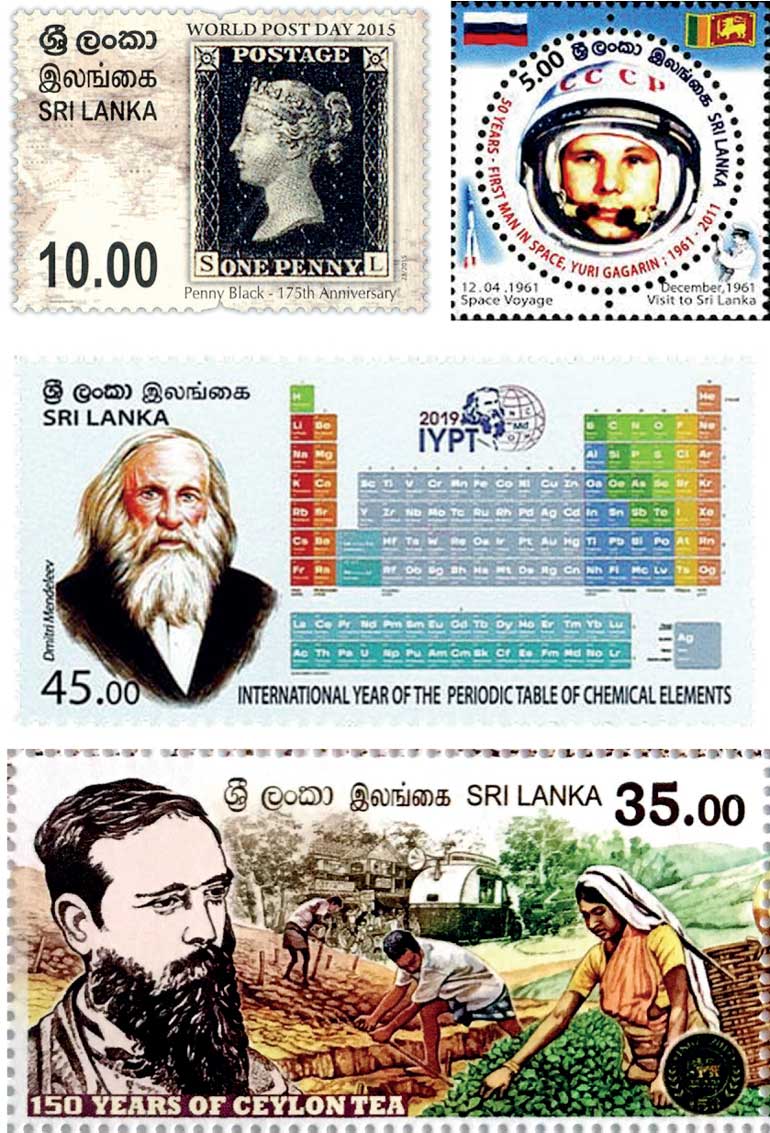Friday May 09, 2025
Friday May 09, 2025
Saturday, 28 December 2024 00:05 - - {{hitsCtrl.values.hits}}


Philately is the study and collection of postage stamps where one can, with just one stamp glean a vast amount of knowledge, ranging from ancient history to contemporary politics, wildlife or the diverse feats of man from architecture to outer space.
To guide us through how to develop skill as a philatelist and insightful ‘stamp researcher,’ we today feature Prathab Kirubaran, a Sri Lankan philatelist specialising in using this hobby to promote general knowledge amongst children, youth and adults. Hailing from Hatton, his last program to promote integrated research through philately for children, was at the Nuwara Eliya Public Library.
By Surya Vishwa
Q: What is the difference between philately and stamp collecting? Is there a difference?
A: Philately and stamp collecting are interconnected but distinct activities. While stamp collecting involves acquiring and organising a variety of stamps, often for their aesthetic or thematic appeal, philately delves deeper into the stories and context behind those stamps. A stamp collector may find joy in amassing a diverse collection, but a philatelist engages in studying the historical, cultural, and political significance of each stamp.
Philately can be described as a research-oriented approach, where the collector becomes a ‘reader’ and analyst of the rich dimensions embedded in every stamp. For instance, in a recent training program I conducted for children aged 7 to 14 at the Nuwara Eliya Public Library, I used a stamp featuring Sirimavo Bandaranaike, Sri Lanka’s and the world’s first female Prime Minister. Through this stamp, I guided the children into a discussion on Sri Lanka’s political history and even genealogy, tracing the Bandaranaike family’s roots back to Kerala, India.
Similarly, a stamp featuring Yuri Alekseyevich Gagarin allowed the children to explore space exploration history. They learned about Gagarin’s historic journey as the first human to orbit the Earth aboard the Vostok 1 spacecraft on April 12, 1961. They were also intrigued to discover that Gagarin visited Sri Lanka, then known as Ceylon, from 7-11 December 1961.
Thus, while stamp collecting focuses on the accumulation and categorisation of stamps, philately extends far beyond, transforming the collection into a gateway to explore and understand broader historical, cultural, and scientific narratives. In this way, philately not only enriches knowledge but also cultivates critical thinking and research skills.
Q: In your program at the Nuwara Eliya Public Library, you adopted an approach that stamps could be an alternative to books in how knowledge can be reaped. Could you explain further?
A: Yes, books are not the sole avenue for learning about human history, geography, anthropology, and other disciplines integral to modern education. Stamps, in my view, represent a vastly underutilised resource for acquiring knowledge. Each stamp carries a story—about a place, an event, a culture, or a significant individual—and serves as a gateway to explore these topics in an engaging and visual way.
If schools were to formally incorporate philately into their curriculum or make it a compulsory extracurricular activity, I am confident it would ignite the dormant general knowledge skills of Sri Lankan students. Philately offers a dynamic, hands-on method to learn, blending curiosity, research, and creativity, which can make learning more impactful and enjoyable.
I speak from personal experience. This hobby transformed my perspective and broadened my understanding of the world. My own philatelic journey began with encouragement from one of my teachers, and it has profoundly influenced my thinking and approach to life. Even my success in fields such as marketing, I attribute to the analytical, observational, and organisational skills honed through this hobby. Philately, I believe, holds the potential to reshape minds dynamically, just as it did for me.
Q: Could you speak of your formal qualifications and career?
A: I began my academic journey at St. John Bosco’s College, where I completed my primary and secondary education, excelling in O/L examinations. Advancing my academic pursuits, I completed my A/Ls in Bio Science at Highlands Central College. My passion for personal and professional growth led me to the Sri Lanka Institute of Marketing (SLIM), where I earned a Postgraduate Diploma in Marketing. I further enhanced my credentials by obtaining a Master of Business Administration (MBA)
from Buckinghamshire New University, UK.
As a proud member of both Sri Lanka Institute of Marketing (SLIM) and the Chartered Institute of Marketing (CIM) UK, I have achieved the prestigious statuses of Chartered Marketer from CIM, Practicing Marketer from SLIM, and Certified Professional Marketer (Asia) from the Asian Marketing Federation (AMF).
Professionally, I embarked on my career at the young age of 20 as a Medical Representative. Today, I serve as the Chief Operating Officer (COO) at MedApp Pvt Ltd. In this role, I oversee the company’s operations related to neurosurgical products, leveraging over two decades of experience in the field.
Beyond my professional accomplishments, I am an avid philatelist with a passion rooted in my childhood. My journey began at the age of 12, inspired by a Tamil lesson taught by my teacher, Mrs. Rajeswary, who introduced me to the art and discipline of stamp collecting. This hobby not only nurtured my love for history and culture but also instilled values that have positively shaped my attitude and outlook on life.
At 15, I joined the Pinibindu Junior Stamp Society, which provided me the opportunity to expand my collection with international stamps. In 2015, I took my interest further by delving into independent learning about philately, eventually evolving into a dedicated philatelist. Today, I celebrate stamp collecting as a cherished hobby, combining it with my professional and personal ethos of continuous learning and growth.
This is a brief yet insightful glimpse into my journey—a blend of professional achievement, and a lifelong passion for philately.
Q: Could you explain the relevance of philately which includes the act of writing and posting letters or postcards, in an age where such actions seem outdated, surrounded as we are within the cocoon of technology.
A: Philately, even in the digital age, remains a relevant and enriching pursuit, bridging the gap between past traditions and modern innovations. Here’s how it stays significant and valuable:
1.Cultural preservation
2.Educational value
3.Emotional connection
4.Tactile experience
5.Environmental and artistic appreciation
6.Rekindling lost practices
7.Community building
8.Cross-generational bonding
9.Digital-physical synergy
10.Sustainability of tradition
While technology has revolutionised how we communicate, the values and experiences offered by philately remain timeless, providing a counterbalance to the ephemeral nature of digital interactions.
Q: How could a parent or child who wants to take to philately further this hobby as a knowledge enhancing complimentary step?
A: Here are some ways
for parents and
children to use philately as a knowledge-enhancing complementary step:
1.Establish a focused theme
2.Participate in stamp exhibitions
3.Join philatelic societies
4.Create a stamp journal
5.Integrate technology
6.Collaborate with schools
7.Expand to related areas
8.Read and research
9.Visit postal museums
10.Take leadership roles
By combining collecting with research, networking, and presentation, parents and children can turn philately into a rich, interdisciplinary learning experience.
Discover Kapruka, the leading online shopping platform in Sri Lanka, where you can conveniently send Gifts and Flowers to your loved ones for any event including Valentine ’s Day. Explore a wide range of popular Shopping Categories on Kapruka, including Toys, Groceries, Electronics, Birthday Cakes, Fruits, Chocolates, Flower Bouquets, Clothing, Watches, Lingerie, Gift Sets and Jewellery. Also if you’re interested in selling with Kapruka, Partner Central by Kapruka is the best solution to start with. Moreover, through Kapruka Global Shop, you can also enjoy the convenience of purchasing products from renowned platforms like Amazon and eBay and have them delivered to Sri Lanka.
Discover Kapruka, the leading online shopping platform in Sri Lanka, where you can conveniently send Gifts and Flowers to your loved ones for any event including Valentine ’s Day. Explore a wide range of popular Shopping Categories on Kapruka, including Toys, Groceries, Electronics, Birthday Cakes, Fruits, Chocolates, Flower Bouquets, Clothing, Watches, Lingerie, Gift Sets and Jewellery. Also if you’re interested in selling with Kapruka, Partner Central by Kapruka is the best solution to start with. Moreover, through Kapruka Global Shop, you can also enjoy the convenience of purchasing products from renowned platforms like Amazon and eBay and have them delivered to Sri Lanka.